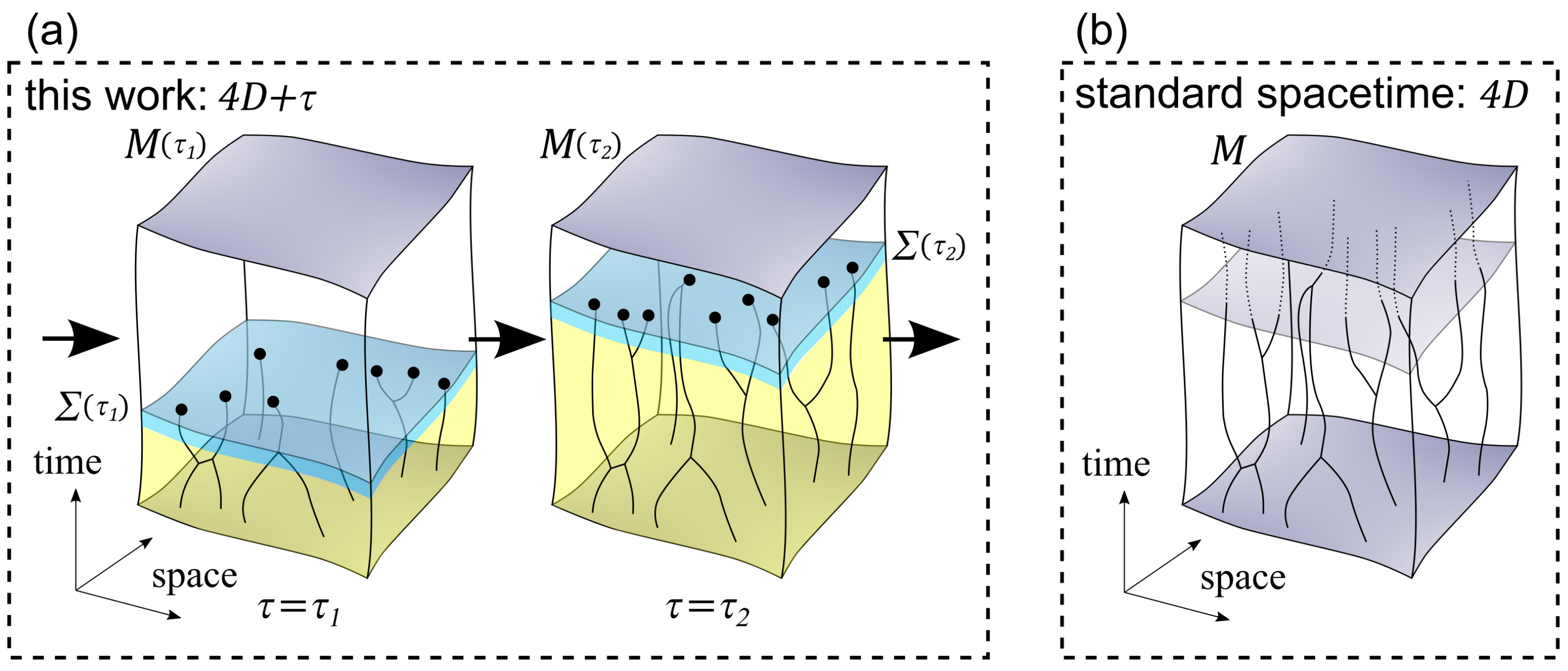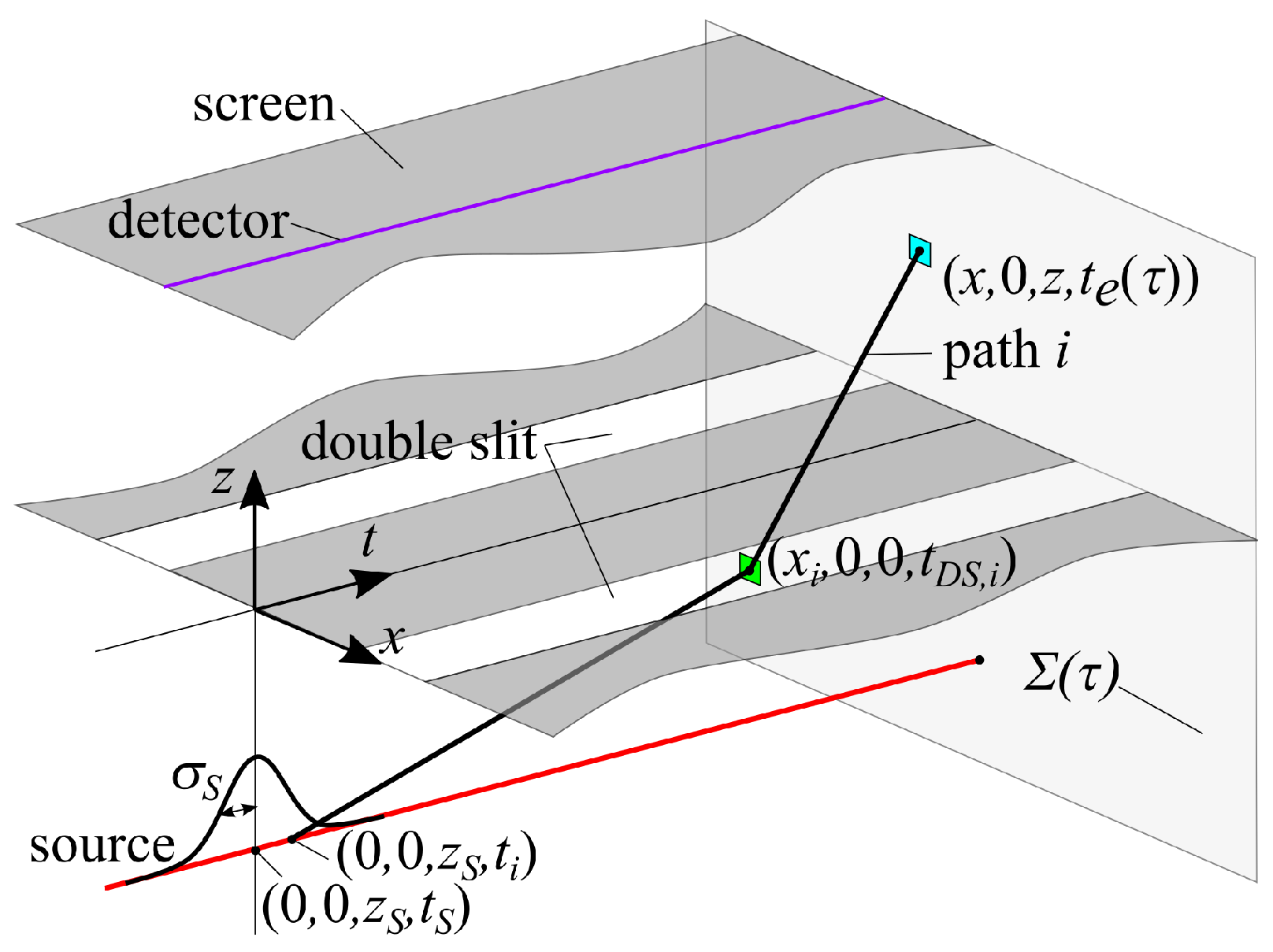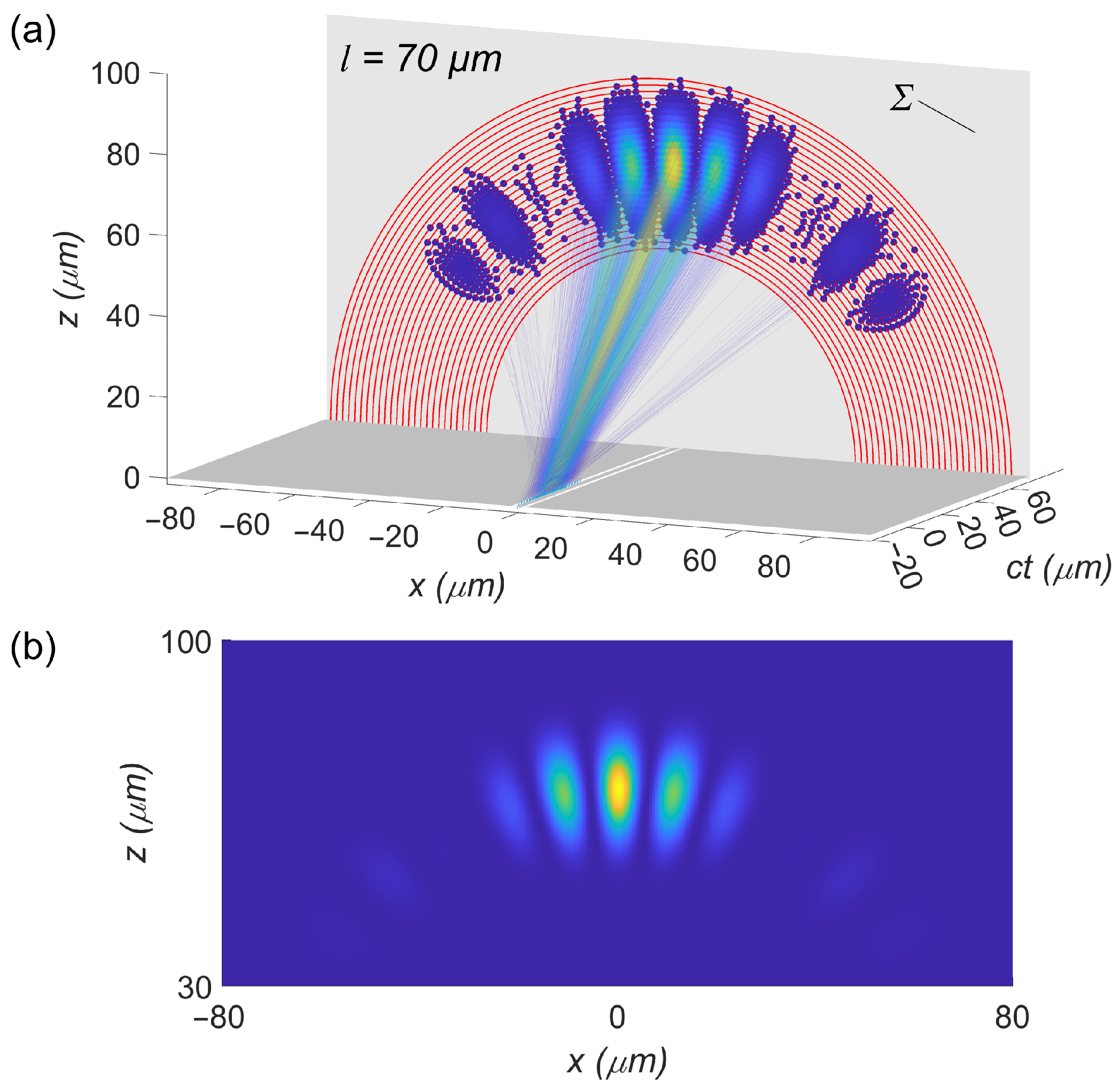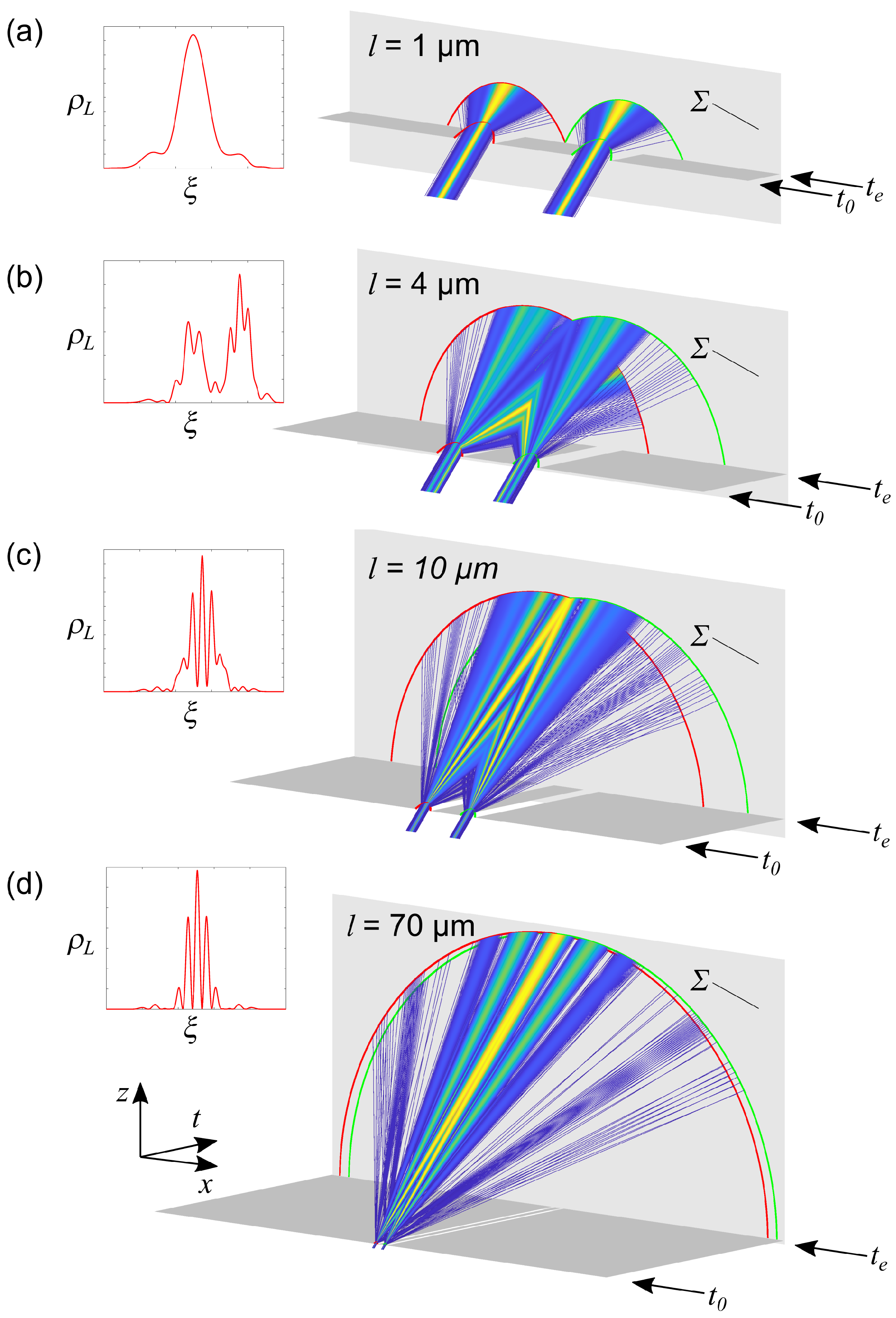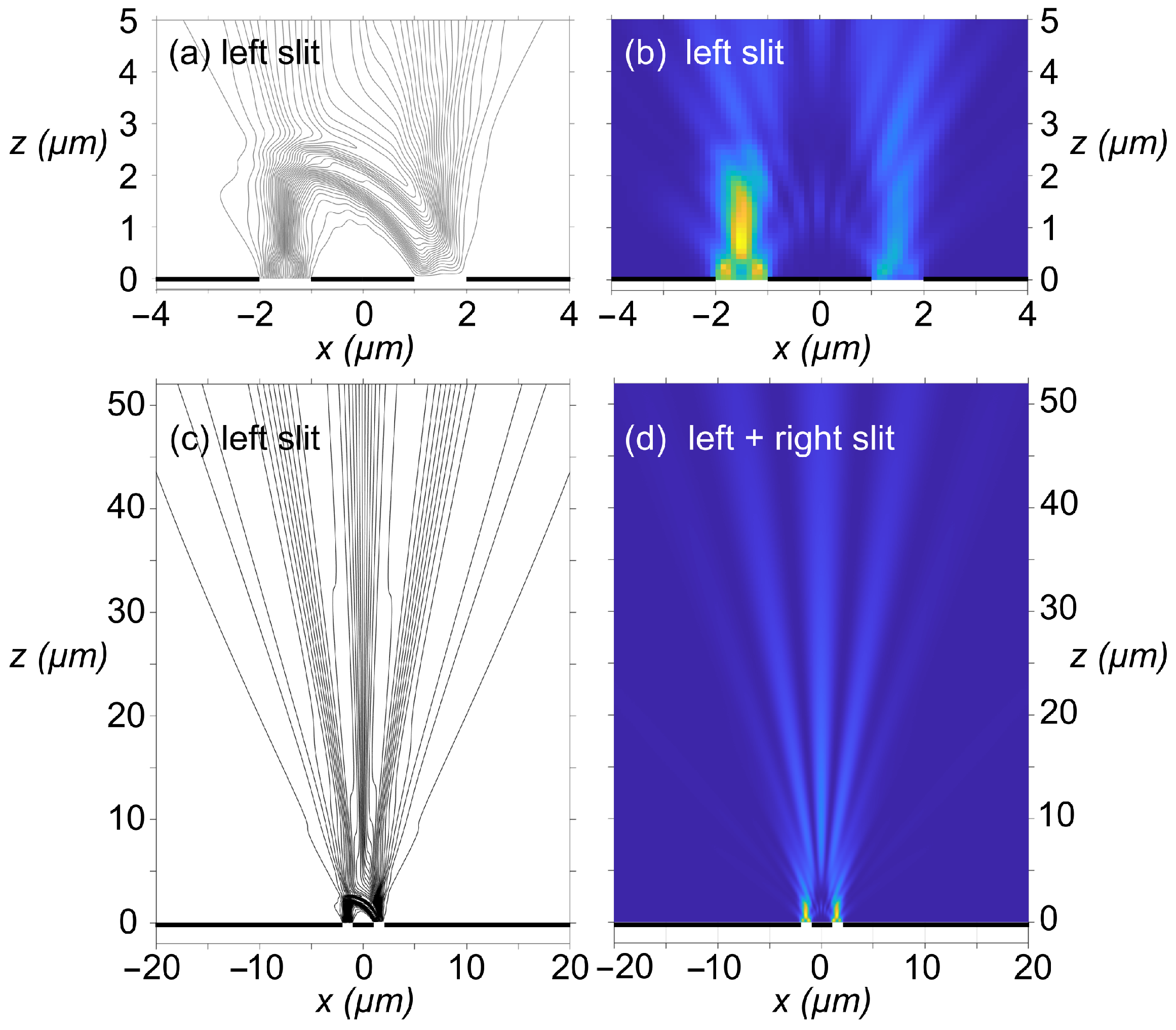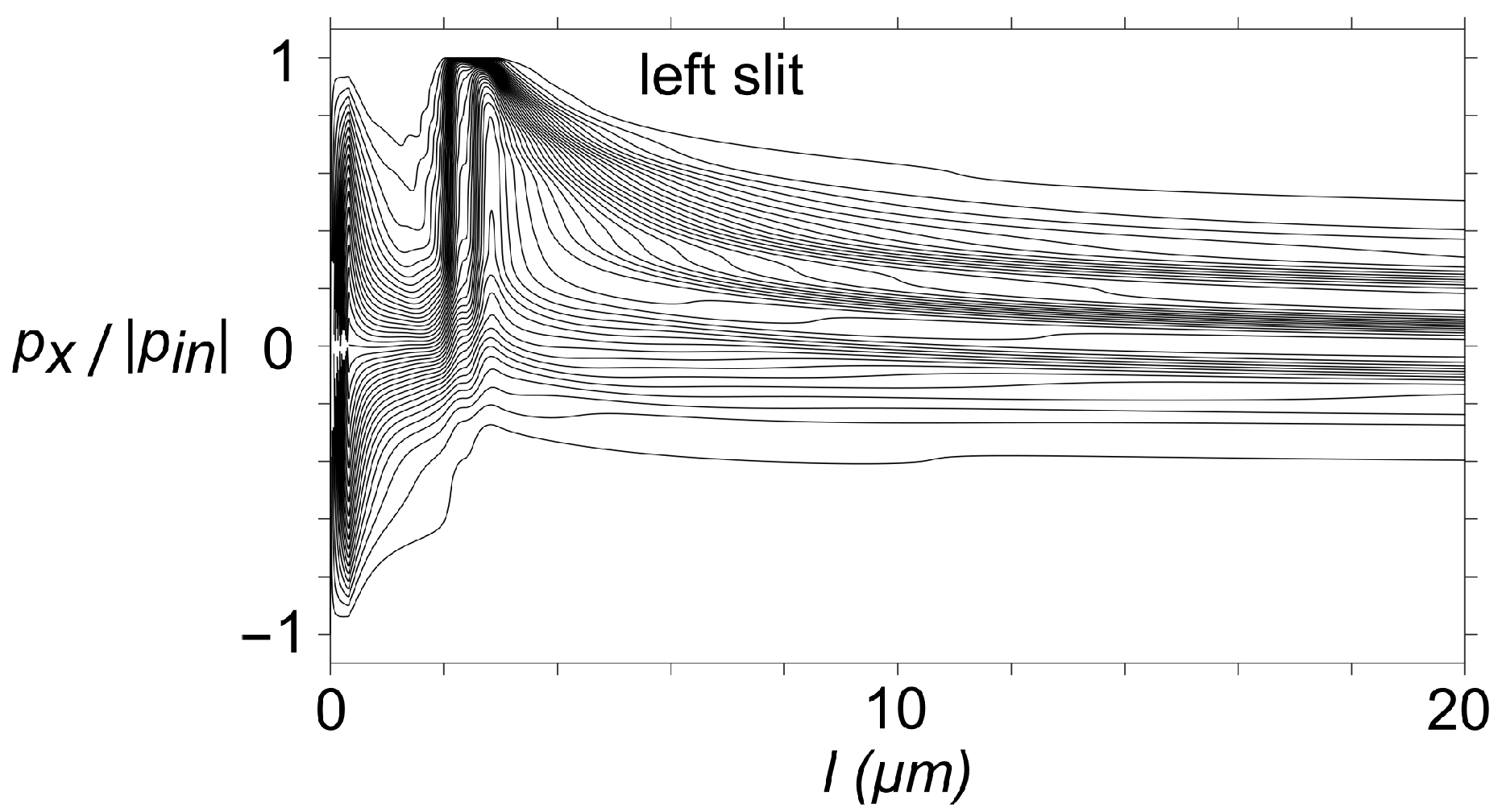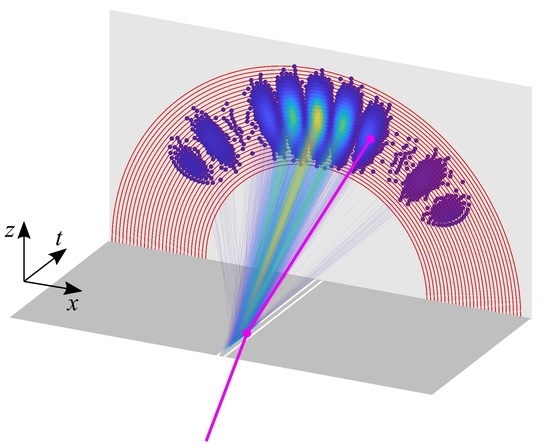2.1. A Modified Spacetime
In this work, 4D spacetime is supplemented with a second form of time represented by the scalar . For each value of , there is an associated four-dimensional spacetime with metric . Mathematically, this results in a structure that can be described as an ordered, continuous set of Lorentzian manifolds with corresponding metrics , labeled with values of the scalar . The interpretation is that standard 4D spacetime M is combined with a scalar evolution parameter to obtain a -dependent 4D block universe . Such four-dimensional spacetime with the external evolution parameter results in a ()-structure, or 4+1 for short. Each 4D spacetime satisfies the Einstein field equations and momentum conservation. To avoid confusion using terminology normally associated with time t, the prefix “-” is used to explicitly specify when dynamics as a function of are considered. Notice that the 4+1 framework is not the same as a five-dimensional spacetime, in which there would be extra space or time coordinates. The problem of time mentioned in the introduction originates precisely from the fact that time in general relativity is reduced to merely a coordinate such that spacetime becomes a static four-dimensional structure. In the 4+1 formalism, re-introduces the analog of an external, absolute time as encountered in classical and quantum mechanics into standard four-dimensional spacetime.
Physically existing entities are characterized by events of the form , where the coordinates for correspond respectively to . It is therefore assumed that the same physical entities exist in different 4D spacetimes associated with the evolution parameter . If the coordinate systems of all spacetimes are chosen wisely, namely such that the coordinates of the elements of reality also vary continuously as a function of , then the path of an element of reality as a function of can be described by a function that maps values of onto four-dimensional coordinates with signature .
Furthermore, worldlines in 4D spacetime that are dynamic as a function of are considered. If individual physical entities constituting a worldline are described as -dynamic events , then the general form of a -dynamic worldline is . This means that at each value of (which specifies the evolution) there is a spacetime in which the worldline is characterized by a set of events of the form with affine parameter pointing at these different events as usual in relativistic mechanics. Notice that, in contrast, a standard worldline in ordinary spacetime is simply characterized by events with affine parameter pointing at individual events. Hence, starting from such a standard worldline , it makes sense to add the evolution parameter to make each event -dynamic, and as a result also the whole worldline. There are certain restrictions in the freedom of -dynamic worldlines. One restriction for worldlines carrying energy and momentum comes from the Einstein equations, which impose that there is conservation of energy and momentum in each spacetime . Physical interactions governed by matter equations can further limit the freedom of worldlines.
Additionally, a physically preferred hypersurface
is introduced that shifts the time dimension in the positive direction as
increases. This hypersurface forms the boundary between a past region of spacetime containing
-dynamic worldlines and a future spacetime region in which worldlines are not yet formed—even though building blocks of these worldlines may already be present there. Hence, it is implied that
itself is associated with the present. A schematic illustration of this concept is shown in
Figure 1a. Here, each spacetime
is split up into two regions separated by a spatial hypersurface
. At each value of
the corresponding hypersurface
is designed such that it contains the endpoints of all involved particle worldlines (dots in
Figure 1a). As the value of the evolution parameter
increases, the worldlines grow in a synchronized way while the hypersurface
advances in the positive direction of the time dimension. It is assumed that far in the past region worldlines are largely constrained by interactions, producing what one could call a crystallized region (yellow region). However, close to the hypersurface
(blue region), the growing ends of the worldlines still have freedom to reorient in four-dimensional spacetime as a function of
, as long as overall energy and momentum conservation is satisfied in each spacetime and the matter equations allow it. This freedom will turn out to be crucial for explaining quantum phenomena. In the region to the future of
, worldlines are not yet formed (white region). In this region, building blocks of worldlines may be present in a still unorganized way.
If we assume that at some value
the region sufficiently to the past of
has reached a rigid configuration (yellow region in
Figure 1a), then the dependency with
can be ignored in this region such that this region can be described as a part of a standard (not
-dependent) spacetime
, satisfying the Einstein field equations and the associated matter equations. When more of spacetime becomes crystallized as
increases, this metric can be further extended up to the new hypersurface
while the previously crystallized part of the metric remains identical. In the limit of
the entire spacetime becomes crystallized and approximates a traditional, fixed spacetime
as it appears in classical general relativity. Standard observers in the
framework, that in fact also consist of
-dynamic worldlines, can make observations in the form of measured events
and can map these events out in ordinary spacetime. However, the
-dynamics of worldlines that occur before a measurement cannot be directly observed. Only the final interaction event can be inferred with standard measurement techniques. The resulting standard 4D spacetime
in agreement with classical general relativity, as it appears according to a standard observer, is illustrated in
Figure 1b. Therefore, by construction, the macroscopic observations agree with classical general relativity, as is desired. In fact, in the 4+1 framework all features of classical relativistic mechanics can be easily reproduced. It suffices to block
-dynamics in the past region of the hypersurface
and to allow only local interactions that conserve momentum. In this case, as
increases and
shifts in the positive direction of the time dimension, an increasing part of a standard spacetime of general relativity is revealed.
Next, by allowing -dynamics of worldlines, it is demonstrated that quantum phenomena can also be reproduced, more specifically double-slit interference.
2.2. The Double-Slit Experiment
Within the 4+1 framework described above, a model for the single-photon double-slit experiment is developed. For simplicity, the theory further restricts to a 4+1 structure based on flat 4D spacetime. On the small spatial scales considered in this work, is assumed to be a flat hypersurface that picks out a preferred coordinate system. The spatial geometry consists of a photon source at position along the negative z-axis (namely , ), a double-slit aperture in the plane and a screen or detector situated at positive z values (unspecified for the moment). Even though the double-slit experiment is spatially a 3D problem, for simplicity and without losing generality the analysis of the photon propagation behind the double slit is restricted to the plane and polarization is ignored. Only the case of a stationary double-slit experiment in the preferred frame linked to the hypersurface is analyzed. In this preferred frame, for a general worldline one can choose to correspond with the start event () and with the end event () in each spacetime associated to a value of . Since the hypersurface contains the end events of all worldlines, it is characterized by the time coordinate . As increases, all worldlines grow in the positive direction of the time dimension at the same rate according to , with a positive scalar. The source emits a single photon characterized in the rest frame by a wavelength and corresponding energy . Two sets of worldlines are created by the source, a “wave network” with worldlines and a “particle network” with worldlines. Worldlines from these two networks are referred to respectively as wave worldlines and particle worldlines. To model a Gaussian wave packet, the number of worldlines created as a function of time in the rest frame follows a Gaussian distribution with a central emission time of and a standard deviation of .
Below, the configuration of wave and particle worldlines is analyzed at a specific value of . The main strategy is as follows. The value of specifies the time coordinate of the hypersurface , constraining the spatial lengths of all involved worldlines. Under this constraint, the configuration of worldlines is governed by a set of equations. This configuration can be seen as a quasi-steady-state situation under the assumption that the interval required for reaching equilibrium is much shorter than what is needed for the worldlines to grow significantly, i.e., . The description below focuses on values of for which most worldlines have already passed the double slit, but the theory can be applied for all values of .
The model insists that all particle and wave worldlines are geodesic, or straight in the present case of flat spacetime, in the absence of interactions with either double slit or detector. The piecewise straight segments can be implemented by minimizing the functional
:
This is the case because, for a single worldline with coordinates
, Equation (
1) leads to the constraint
, which represents a straight line. Here,
is the Minkowski metric of flat spacetime and since we are describing a photon, it is imposed that all wave and particle worldlines are piecewise null geodesics.
The wave network is used to produce a measure
Q for the probability of finding the photon in the hypersurface
that agrees well with standard quantum theory. The approach is similar to the path integral formalism, but relies solely on null geodesic wave worldlines.
Figure 2 schematically shows the geometry of a single wave worldline. Wave worldlines emanate spatially isotropically from the source in its rest frame. Considering the small dimensions of the double-slit aperture and the long distance from the source, wave worldlines are incident on the double slit in a quasi-parallel bundle along the
z axis. Since the model focuses on photon propagation in the
plane behind the double slit, a simple scattering model is adopted. Worldlines that pass through the double-slit openings are scattered (deflected) spatially only in the
x direction while there is no deflection in the
y direction. The deflection angle
is assumed to be random with a uniform probability
in the rest frame with respect to incidence. Based on this scattering model, the number of wave worldlines that arrive in a finite surface area
near the position
in the hypersurface
(blue square in
Figure 2) can be estimated as follows. From the target position
, several paths
i can be traced back to the double-slit aperture and further back to the source. For path
i, the deflection event at the double slit is
, with
the position in the double-slit aperture and
the corresponding time coordinate. The emission event at the source is
, with
. The number of wave worldlines
that approximately follow path
i and that pass through a similar area
at the position
(green square in
Figure 2) is:
Here, the first factor,
, represents the number of wave worldlines emitted by the source at the time
associated with path
i taking into account the Gaussian wave packet produced by the source:
The second factor in Equation (
2) accounts for the 3D dilution before the double slit, where
is the spatial distance from the emission event at the source to the deflection point at the double slit. A good approximation is
. The last factor in Equation (
2) accounts for the 2D dilution behind the double slit, where
is the remaining spatial distance to the event
in the hypersurface
. For large values of
, this factor reduces to
, which represents the fraction of the angle
under which worldlines are incident on the surface area
at position
, to the full angle
of all outgoing worldlines. For small values of
at positions
approaching
, this factor reduces to 1 as is desired because there is no dilution behind the double slit. Each worldline
i also has a total path length
between the source event and the end event at
, with corresponding phase
:
A suitable measure for probability
Q at coordinates
in
is defined as:
where the double summation goes over
K paths from source, via positions
(with
) in the double-slit aperture separated by a distance
, to the position
in
. Equation (
5) has similarities with the path integral formalism in that it also depends on paths through the double-slit aperture and their phases. In fact, in the far field, paraxial approximation, Equation (
5) becomes identical to the following typical path integral:
since in this case
becomes a constant density of worldlines. The main reason why Equation (
5) is preferred here is because it is based solely on null geodesic worldlines, it is expressed explicitly without imaginary numbers and it produces a measure for probability that scales as desired under Lorentz transformations (see [
41]).
Next, the configuration of particle worldlines is determined, as illustrated in
Figure 3a. Since we are interested in photon propagation in the
plane, only particle worldlines in the
plane (with
) are considered. The aim is to organize the particle worldlines such that their endpoints in the hypersurface
have a spatial density in the
plane that is in good approximation proportional to the quantum distribution
. There are many ways in which one could arrange the particle worldlines in such a way. Here, a mechanism is chosen that not only determines the end events of the particle worldlines but the entire worldlines. Particle worldlines are chosen to emanate from the source in discrete subgroups, labeled
p, which are associated to uniformly spaced emission times
and that behave independently from each other. For each subgroup
p, many particle worldlines are emitted in the same emission event
at the source. Similar to the wave network with Equation (
3), the number of particle worldlines emitted at time
follows a Gaussian distribution in time centered around
with a standard deviation of
. The spatial density of particle worldlines
of one subgroup
p, defined as the number of worldlines per unit distance along a curve orthogonal to the particle worldlines near the event
, is determined such that it satisfies:
Here,
is a four-vector orthogonal to the worldlines,
∂ is the four-gradient, and
takes the scalar value equal to
sampled at the end event of the worldline passing through coordinates
. Along an orthogonal curve labeled by a suitable coordinate
as shown in
Figure 3a, Equation (
7) simplifies to:
where
has been replaced by the corresponding value of
along the orthogonal curve. This demonstrates that along an orthogonal curve labeled with coordinate
(see
Figure 3a),
is constant, or in other words,
is proportional to
. As a consequence, the spatial density of particle worldlines along an orthogonal curve, and in good approximation the spatial distribution of the endpoints of the particle worldlines in
, are proportional to the quantum distribution
Q, as is desired. For each orthogonal curve, the value of the constant
is automatically known from the additional boundary condition that the worldlines tend to fill the entire forward hemisphere in order to minimize the local worldline density. With this boundary condition, the spatial distribution of particle worldlines along an orthogonal curve satisfying Equation (
8) becomes:
Here,
is a similar density of worldlines emitted by the source at the corresponding time
as in Equation (
3), but for a total of
particle worldlines that pass one of the slits. The important consequence of Equation (
9) is that
turns out to be a properly normalized probability distribution that is proportional to the quantum measure
. It also means that the parallel incoming particle worldlines are forced to spread out and to fill the entire space behind the double slit without overlapping each other, as is illustrated in
Figure 3a. Since for all orthogonal curves the scalars
are related to the same scalars
Q at the endpoints of the associated worldlines, a similar spatial density is expected along all orthogonal curves.
Since Equation (
1) insists that particle worldlines are piecewise geodesic, it is proposed that a sharp transition occurs from parallel incoming worldlines to radially outgoing worldlines at a single disclination line (see
Figure 3b–d). In both regions before and after the double slit the worldlines are null geodesics and there is a single spatial deflection at the disclination line near the double slit. A suitable disclination line (independent of the
y direction) that enables to connect bundles of parallel incoming and radially outgoing worldlines for the subgroup emitted at source time
is expressed by coordinates
satisfying:
as illustrated in
Figure 3b–d. This disclination line is limited to
-values that are, to the left and to the right of the center of the slits, closer than
but further than
, where
max
. In these (in total) four regions, worldlines spread out spatially radially from virtual centers located at
and
on the
x axis. As a result, a typical particle worldline passing through the double-slit aperture at position
experiences a single interaction event
governed by Equation (
10) and ends at the hypersurface
in the event
(see
Figure 3a). For each subgroup, the spatial length of the particle worldlines between the double slit and the hypersurface
is
. If the particle worldlines have a spatial length
l beyond the double slit larger than
, then
is such that the worldlines are radiating outwards from virtual points at the center of the corresponding slit, namely at
(see
Figure 3d). If their lengths
l are shorter than
, then there are two regions at the left and right side of each slit (see
Figure 3c). In these regions, the worldlines have a spatial angle in the
plane with respect to the
z axis that changes smoothly from 0 to
, with the ± sign corresponding to the right or left side of each slit. In all cases, the shape of the disclination line ensures that the different regions before and after the double slit can be connected through piecewise straight paths. It also means that the
x position of an incoming path is automatically linked to the spatial angle of the corresponding outgoing path.
Now, it is verified to which extent the chosen disclination line in Equation (
10) is compatible with Equations (
1) and (
7) (or Equation (
9)). In the far field, which occurs for large values of
l and sufficiently far from the interaction region with the double slit, each subgroup of particle worldlines passing one of the slits falls in good approximation on a single light cone. In this case, in the rest frame, all orthogonal curves are semicircles with spatial radii
increasing as a function of the time coordinate
t with respect to the time
corresponding to the tip of the light cone. Therefore, for all orthogonal curves a similar spatial distribution of worldlines is obtained with Equation (
7) (or Equation (
9)), except that it is spatially stretched and normalized differently since the spatial length of each orthogonal curve
increases proportionally with time
t. As a result, the organization of particle worldlines is indeed compatible with straight worldlines, as is preferred from Equation (
1). In the near field and close to the double slit, particle worldlines of one subgroup do not exactly follow a single light cone because of the chosen shape of the disclination line. Equation (
7) then actually prefers a slight deviation from straight worldlines in the region close to the double slit, such that in a more detailed analysis of this region, more than one disclination line is needed. However, if the geodesic contribution from Equation
1 is dominant in this region, the worldlines may still prefer to be straight up to the disclination line of Equation (
10). For simplicity, the latter will be assumed.
Under the above assumptions, a consistent model for particle worldlines is obtained. The regions of parallel incoming and radially outgoing worldlines consist of straight worldlines as desired by Equation (
1) and are connected at a single disclination line (Equation (
10)). Within each region, the spatial distribution is governed by Equation (
7) (and Equation (
9)). Since the spatial density distribution of particle worldlines along different orthogonal curves is essentially the same (apart for the radial expansion after the double slit) it suffices to calculate this distribution once for a single slit and for an orthogonal curve with coordinate
chosen sufficiently far from the disclination line. A convenient choice is to select an orthogonal curve in the region of the parallel incoming worldlines for one slit. Then, based on the resulting distribution
(for the left slit), the full geometry of the particle worldlines can immediately be calculated using the shape of the disclination line and the basic geometry shown in
Figure 3.
